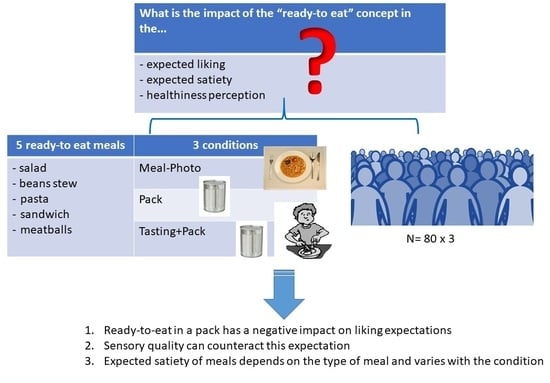Do Consumers Change Their Perception of Liking, Expected Satiety, and Healthiness of a Product If They Know It Is a Ready-to Eat Meal?
Abstract
1. Introduction
2. Materials and Methods
2.1. Ready-to-Eat Meals
2.2. Consumer Tests
2.3. Data Analysis
3. Results and Discussion
3.1. Consumer Liking
3.2. Effect of Evaluation Condition on the Liking Scores
3.3. Effect of Evaluation Conditions on Expected Satiety
3.4. Effect of Evaluation Conditions on Healthiness Perception
4. Conclusions
Author Contributions
Funding
Acknowledgments
Conflicts of Interest
Appendix A
| Product | Nutrition Facts (per 100 g of product) | |||||||
|---|---|---|---|---|---|---|---|---|
| Energy (kcal) | Fat (g) | Saturated Fat (g) | Carbohydrates (g) | Free Sugars (g) | Fibre (g) | Protein (g) | Salt (g) | |
| Pasta | 129 | 7.2 | 3 | 11.9 | 1.1 | 0.6 | 4.3 | 1.3 |
| Meatballs | 118 | 5.5 | 1.7 | 6.5 | 3.1 | 1 | 9.9 | 1.7 |
| Salad | 181 | 10.9 | 5.5 | 12.6 | 4.05 | 1.8 | 6.8 | 0.9 |
| Beans | 142 | 8.3 | 3.1 | 7.9 | 0.7 | 5.2 | 6.4 | 0.9 |
| Sandwich | 186 | 10 | 2 | 20 | 3.3 | - | 4.6 | 0.8 |
References
- James, S.; James, C. Minimal processing of ready meals. In Emerging Technologies for Food Processing; Elsevier: Amsterdam, The Netherlands, 2014; pp. 599–612. [Google Scholar]
- Simmonds, G.; Spence, C. Thinking inside the box: How seeing products on, or through, the packaging influences consumer perceptions and purchase behaviour. Food Qual. Prefer. 2017, 62, 340–351. [Google Scholar] [CrossRef]
- ASEFAPRE. El Consumo de Platos Preparados Con Base de Verduras Creció Cerca Del 40%. 2018. Available online: http://www.hoyplatospreparados.es/el-consumo-de-pl (accessed on 1 May 2020).
- Statista. Ready Meals—Europe. 2018. Available online: https://www.statista.com/outlook/40080100/102/Ready-meals/europe?currency=gbp (accessed on 1 May 2020).
- Celnik, D.; Gillespie, L.; Lean, M. Time-scarcity, ready-meals, ill-health and the obesity epidemic. Trends Food Sci. Technol. 2012, 27, 4–11. [Google Scholar] [CrossRef]
- Bowers, D. Cooking trends echo changing roles of women. Food Rev./Natl. Food Rev. 2000, 23, 23–29. [Google Scholar]
- Sgroi, F.; Piraino, F.; Donia, E. Determinants of Ready-to-eat Products Purchase Intentions: An Empirical Study among the Italian Consumers. HortScience 2018, 53, 656–660. [Google Scholar] [CrossRef]
- Bonke, J. Economic Influences on Food Choice—Non-Convenience versus Convenience Food Consumption. In Food Choice, Acceptance and Consumption; Springer Science and Business Media LLC.: Berlin, Germany, 1996; pp. 293–318. [Google Scholar]
- Darian, J.C.; Tucci, L.A. Convenience-Oriented Food Expenditures of Working-Wife Families: Implications for convenience food manufacturers. J. Food Prod. Mark. 1992, 1, 25–36. [Google Scholar] [CrossRef]
- Costa, A.I.A.; Schoolmeester, D.; Dekker, M.; Jongen, W.M. To cook or not to cook: A means-end study of motives for choice of meal solutions. Food Qual. Prefer. 2007, 18, 77–88. [Google Scholar] [CrossRef]
- Brunsø, K.; Fjord, T.A.; Grunert, K.G. Consumers’ Food Choice and Quality Perception; Aarhus Sch Bus Publ: Aarhus, Denmark, 2002; pp. 1–60. [Google Scholar]
- Costell, E.; Tárrega, A.; Bayarri, S. Food Acceptance: The Role of Consumer Perception and Attitudes. Chemosens. Percept. 2009, 3, 42–50. [Google Scholar] [CrossRef]
- Becker, L.; Van Rompay, T.J.L.; Schifferstein, H.N.J.; Galetzka, M. Tough package, strong taste: The influence of packaging design on taste impressions and product evaluations. Food Qual. Prefer. 2011, 22, 17–23. [Google Scholar] [CrossRef]
- Piqueras-Fiszman, B.; Spence, C. Crossmodal correspondences in product packaging. Assessing color–flavor correspondences for potato chips (crisps). Appetite 2011, 57, 753–757. [Google Scholar] [CrossRef]
- Albuquerque, T.G.; Santos, J.; Silva, M.A.; Oliveira, M.B.P.; Costa, H.S. An update on processed foods: Relationship between salt, saturated and trans fatty acids contents. Food Chem. 2018, 267, 75–82. [Google Scholar] [CrossRef]
- Christoforou, A.; Dunford, E.; Neal, B. Changes in the sodium content of Australian ready meals between 2008 and 2011. Asia Pac. J. Clin. Nutr. 2013, 22, 138. [Google Scholar] [PubMed]
- Kanzler, S.; Hartmann, C.; Gruber, A.; Lammer, G.; Wagner, K.-H. Salt as a public health challenge in continental European convenience and ready meals. Public Health Nutr. 2014, 17, 2459–2466. [Google Scholar] [CrossRef] [PubMed]
- Kanzler, S.; Manschein, M.; Lammer, G.; Wagner, K.-H. The nutrient composition of European ready meals: Protein, fat, total carbohydrates and energy. Food Chem. 2015, 172, 190–196. [Google Scholar] [CrossRef] [PubMed]
- Remnant, J.; Adams, J. The nutritional content and cost of supermarket ready-meals. Cross-sectional analysis. Appetite 2015, 92, 36–42. [Google Scholar] [CrossRef] [PubMed]
- Roe, M.A.; Pinchen, H.; Church, S.; Elahi, S.; Walker, M.; Farron-Wilson, M.; Buttriss, J.; Finglas, P.M. Trans fatty acids in a range of UK processed foods. Food Chem. 2013, 140, 427–431. [Google Scholar] [CrossRef]
- Choi, E.; Kim, B.H. A comparison of the fat, sugar, and sodium contents in ready-to-heat type home meal replacements and restaurant foods in Korea. J. Food Compos. Anal. 2020, 92, 103524. [Google Scholar] [CrossRef]
- Brunstrom, J.M.; Collingwood, J.; Rogers, P.J. Perceived volume, expected satiation, and the energy content of self-selected meals. Appetite 2010, 55, 25–29. [Google Scholar] [CrossRef]
- Brunstrom, J.M.; Shakeshaft, N.G.; Brunstrom, J.M. Measuring affective (liking) and non-affective (expected satiety) determinants of portion size and food reward. Appetite 2009, 52, 108–114. [Google Scholar] [CrossRef]
- Oliver, R.L. A cognitive model of the antecedents and consequences of satisfaction decisions. J. Mark. Res. 1980, 17, 460–469. [Google Scholar] [CrossRef]
- Tomadoni, B.; Fiszman, S.; Moreira, M.R.; Tárrega, A. The Role of the Dynamic Sensory Perception in the Reformulation of Shakes: Use of TDS for Studying the Effect of Milk, Fiber, and Flavor Addition. J. Food Sci. 2017, 83, 198–204. [Google Scholar] [CrossRef]
- Motoki, K.; Saito, T.; Nouchi, R.; Kawashima, R.; Sugiura, M. Tastiness but not healthfulness captures automatic visual attention: Preliminary evidence from an eye-tracking study. Food Qual. Prefer. 2018, 64, 148–153. [Google Scholar] [CrossRef]
- Reed, Z.; McIlveen-Farley, H.; Strugnell, C. Factors affecting consumer acceptance of chilled ready meals on the island of Ireland. Int. J. Consum. Stud. 2003, 27, 2–10. [Google Scholar] [CrossRef]
- Song, H.; Schwarz, N. If It’s Difficult to Pronounce, It Must Be Risky. Psychol. Sci. 2009, 20, 135–138. [Google Scholar] [CrossRef] [PubMed]
- Shim, S.-M.; Seo, S.; Lee, Y.; Moon, G.-I.; Kim, M.-S.; Park, J.-H. Consumers’ knowledge and safety perceptions of food additives: Evaluation on the effectiveness of transmitting information on preservatives. Food Control 2011, 22, 1054–1060. [Google Scholar] [CrossRef]
- Bearth, A.; Cousin, M.-E.; Siegrist, M. The consumer’s perception of artificial food additives: Influences on acceptance, risk and benefit perceptions. Food Qual. Prefer. 2014, 38, 14–23. [Google Scholar] [CrossRef]
- Dohle, S.; Rall, S.; Siegrist, M. Does self-prepared food taste better? Effects of food preparation on liking. Health Psychol. 2016, 35, 500–508. [Google Scholar] [CrossRef] [PubMed]
- Giampietri, E.; Verneau, F.; Del Giudice, T.; Carfora, V.; Finco, A. A Theory of Planned behaviour perspective for investigating the role of trust in consumer purchasing decision related to short food supply chains. Food Qual. Prefer. 2018, 64, 160–166. [Google Scholar] [CrossRef]
- Richards, R.; Brown, L.B.; Williams, D.P.; Eggett, D.L. Developing a Questionnaire to Evaluate College Students’ Knowledge, Attitude, Behavior, Self-efficacy, and Environmental Factors Related to Canned Foods. J. Nutr. Educ. Behav. 2017, 49, 117–124. [Google Scholar] [CrossRef]
- Perez-Cueto, F.; Dos Santos, Q.; Nielsen, B.; Dinnella, C.; Monteleone, E.; Giboreau, A.; Saulais, L.; Depezay, L.; Hartwell, H.; Appleton, K.M. Danish adolescents like their vegetables fresh rather than frozen or canned. Int. J. Gastron. Food Sci. 2017, 9, 29–33. [Google Scholar] [CrossRef]
- Buckland, N.J.; Stubbs, R.J.; Finlayson, G. Towards a satiety map of common foods: Associations between perceived satiety value of 100 foods and their objective and subjective attributes. Physiol. Behav. 2015, 152, 340–346. [Google Scholar] [CrossRef]
- Vadiveloo, M.K.; Morwitz, V.; Chandon, P. The interplay of health claims and taste importance on food consumption and self-reported satiety. Appetite 2013, 71, 349–356. [Google Scholar] [CrossRef] [PubMed]
- Spence, M.; Stancu, V.; Dean, M.; Livingstone, M.B.E.; Gibney, E.R.; Lähteenmäki, L. Are food-related perceptions associated with meal portion size decisions? A cross-sectional study. Appetite 2016, 103, 377–385. [Google Scholar] [CrossRef] [PubMed]
- Fiszman, S.; Tárrega, A. Expectations of food satiation and satiety reviewed with special focus on food properties. Food Funct. 2017, 8, 2686–2697. [Google Scholar] [CrossRef] [PubMed]
- González, A.; Recio, S.A.; Sànchez, J.; Gil, M.; De Brugada, I. Effect of exposure to similar flavours in sensory specific satiety: Implications for eating behaviour. Appetite 2018, 127, 289–295. [Google Scholar] [CrossRef]
- Naruseviciute, G.; Whybrow, S.; MacDiarmid, J.I.; McNeill, G. Is “home cooked” healthier and cheaper than ready meals? Proc. Nutr. Soc. 2015, 74. [Google Scholar] [CrossRef]
- Bucher, T.; Muller, B.; Siegrist, M. What is healthy food? Objective nutrient profile scores and subjective lay evaluations in comparison. Appetite 2015, 95, 408–414. [Google Scholar] [CrossRef]
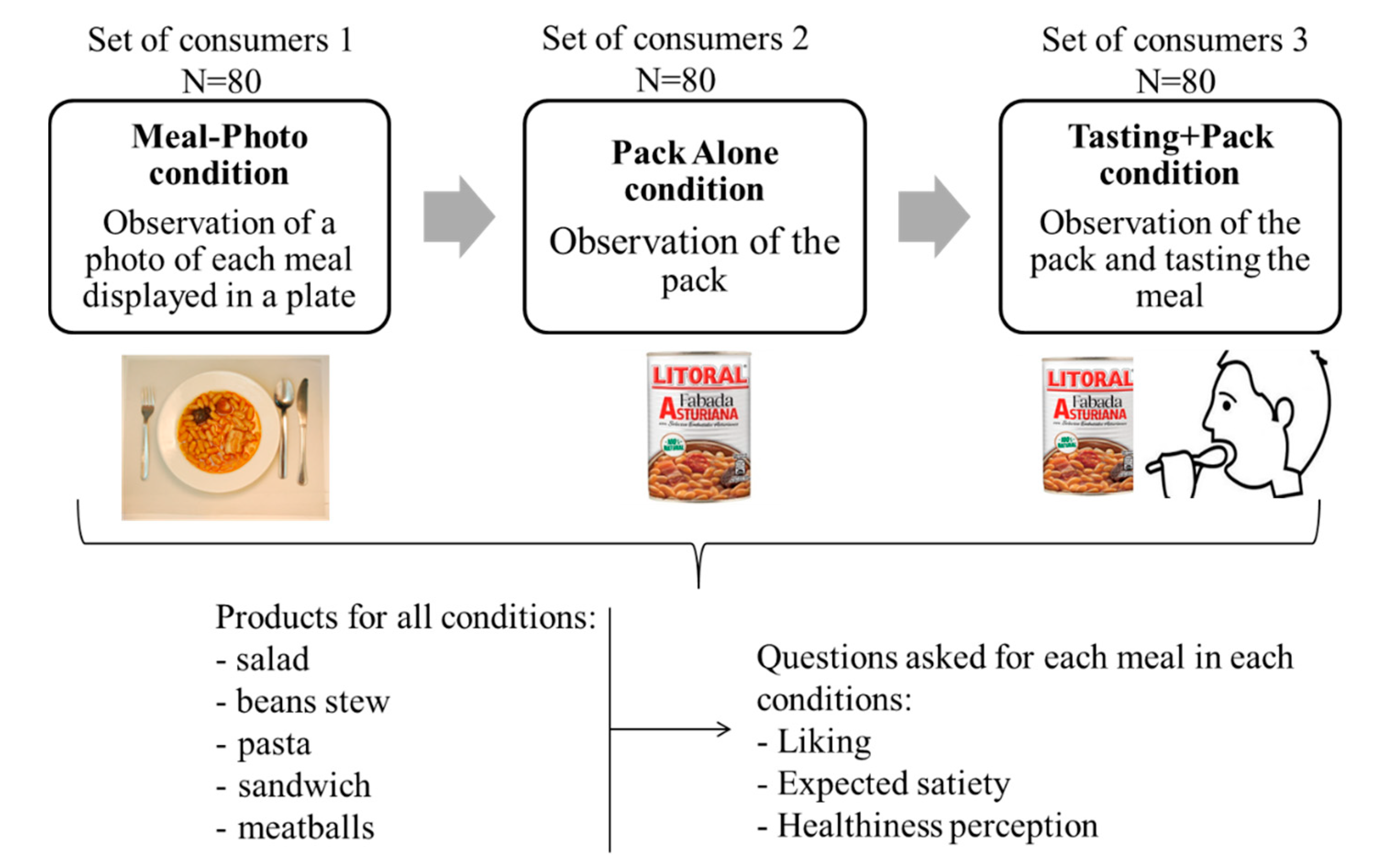

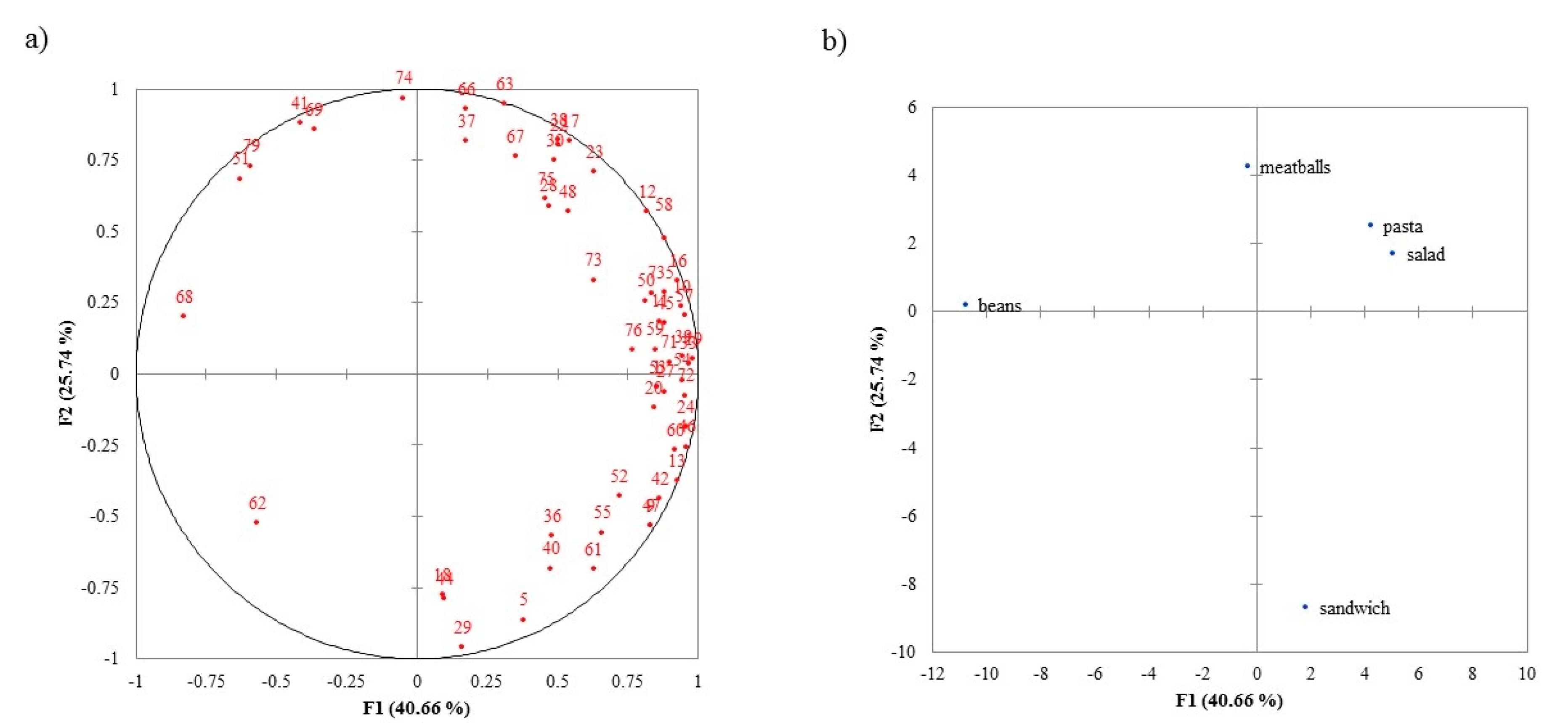
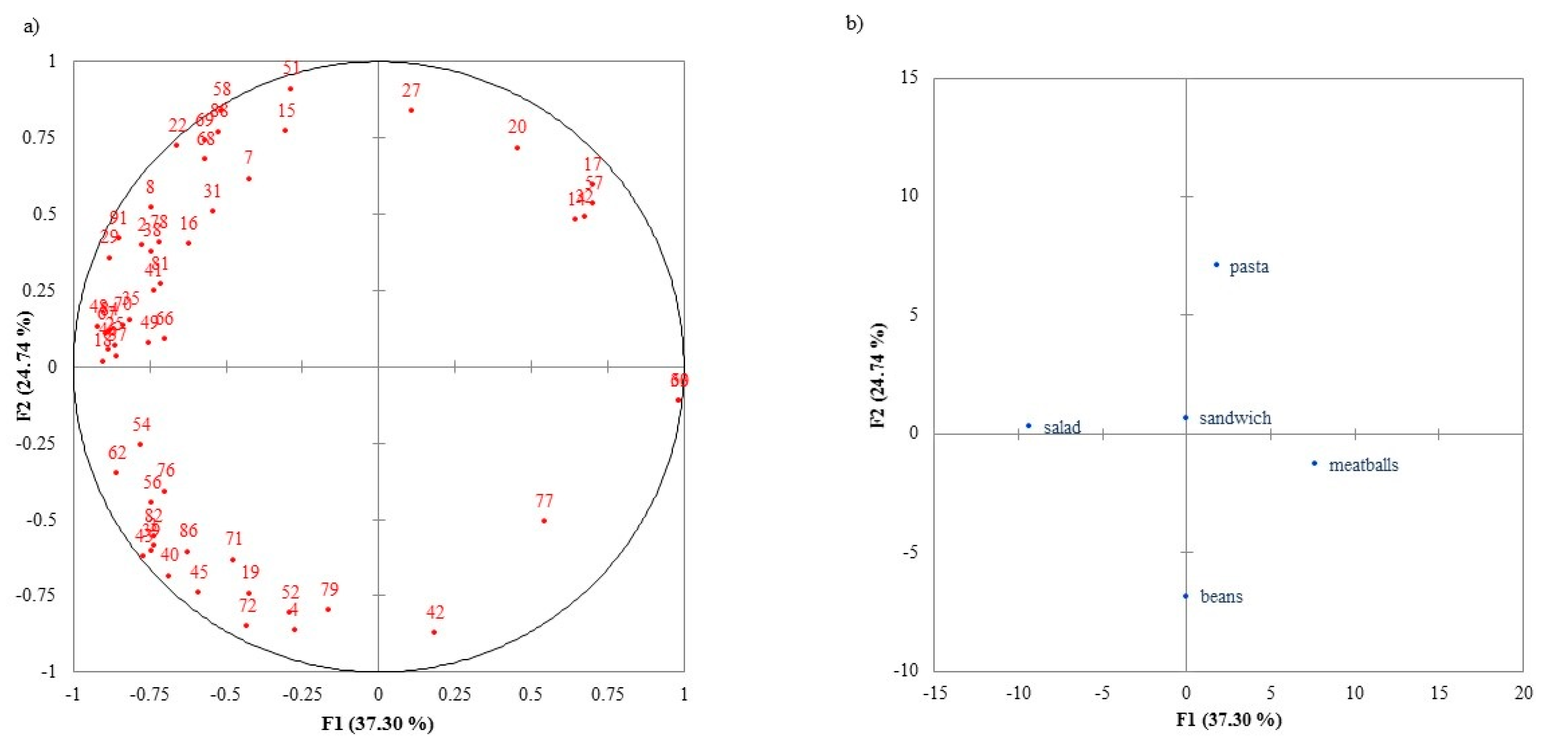



| Meal | List of Ingredients | Packaging Material | Images on the Pack |
|---|---|---|---|
| Pasta | Pasta, carbonara sauce *, onion, smoked bacon ** | White plastic tray cover with opaque plastic film inside cardboard envelope | Pasta served on a dish |
| * Carbonara sauce ingredients: Water, cream powder (dairy), sunflower oil, salt, modified corn starch, flavour (dairy), smoke flavour, stabiliser (xanthan gum), natural flavour, white pepper, and soy lecithin ** Smoked bacon ingredients: Bacon pork, water, salt, sugar, stabiliser (e-451), antioxidant (e-316), aroma of natural smoke, and spices | |||
| Meatballs | Pork Meatballs *, tomato sauce **, vegetables [potato, peas, carrot, onion, mushroom] | White plastic tray cover with opaque plastic film inside cardboard envelope | Meatballs served on a dish |
| * Meatball ingredients: Lean pork, water, white breadcrumbs (wheat flour (gluten), water, salt, and yeast), egg, salt, onion, garlic, and parsley ** Tomato sauce ingredients: Tomato, water, wine, sugar, modified corn starch, olive oil, natural flavour (gluten and soy), salt and, black pepper | |||
| Salad | Curly escarole, radicchio, canon, Modena and honey sauce *, bacon **, onion ***, gouda, cheddar cheeses | Transparent plastic tray | No images presented, but the salad ingredients can be seen through the packaging |
| * Modena and honey sauce: Water, sugar, Modena balsamic vinegar (5%), honey (3%), colouring (E150c), salt, sunflower oil, acidifier (E260), stabiliser (E415), preservative (E202) ** Bacon: Pork belly, salt, sugar, corn dextrose, flavourings, stabilisers (E451, E407), flavour enhancer (E621), antioxidant (E316, E331), preservative (E250), coating agent (edible gelatin, E200), frying oil (sunflower), and antioxidants (E320, E321) *** Onion (7%): Onion, vegetable oil (palm), wheat flour, salt. Toasted wheat bread cubes: wheat flour (86%), vegetable oil (sunflower), dextrose, wheat gluten, yeast, salt, buttermilk, barley malt extract, and antioxidant (ascorbic acid) | |||
| Beans | Beans, water, chorizo *, black pudding **, smoked bacon ***, pig lard, salt | Tin can | Beans served on a traditional casserole-like dish |
| * Chorizo: Lean meat, chin and smoked pork belly, salt, paprika, and garlic ** Black pudding: Pig lard, pig chin and smoked bacon, blood and lean pork meat, onion, paprika, salt, and oregano *** Smoked bacon: Pork belly, salt, and natural smoke | |||
| Sandwich | Bread *, tomato, lettuce, mayonnaise, hard-boiled egg, soybean oil, water, EGG yolk, vinegar, sugar, salt, starch, flavour, concentrated lemon juice, antioxidant E-385, colourants (paprika extract, E-160a) | Transparent plastic film and black plastic triangle | No images presented, but the sandwich and filling can be seen through the package |
| * Bread ingredients: wheat flour, water, yeast, sunflower oil, sugar, salt, WHEAT gluten, preservatives (E-282, E-200, E-202), starch, and soya flour | |||
| Meatballs | Salad | Beans | |
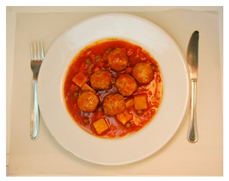 | 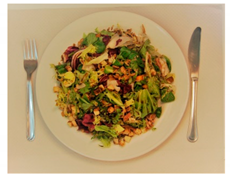 |  | |
| Pasta | Sandwich | ||
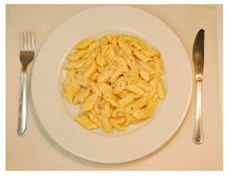 | 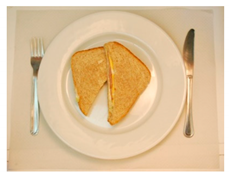 | ||
| Product | Scenario | ||
|---|---|---|---|
| Meal-Photo * | Pack * | Tasting-Pack * | |
| Pasta | 7.1 (1.5) a | 6.6 (1.9) a,b | 6.1 (2.3) b |
| Meatballs | 6.2 (2.1) b,c | 5.7 (2.0) b,c | 5.3 (2.1) b |
| Salad | 7.5 (1.6) a | 6.8 (2.0) a | 7.4 (1.5) a |
| Beans | 5.8 (2.3) c | 4.7 (2.3) d | 6.0 (2.3) b |
| Sandwich | 7.0 (1.8) a,b | 5.6 (2.3) c,d | 5.9 (2.2) b |
| Product | Condition | ||
|---|---|---|---|
| Meal-Photo * | Pack * | Tasting + Pack * | |
| Pasta | 5.3 (1.0) a | 5.7 (1.0) a | 5.6 (0.9) a,b |
| Meatball | 5.4 (1.1) a | 5.5 (1.1) a | 5.8 (1.3) b |
| Salad | 4.0 (1.2) b | 3.9 (1.3) b | 4.0 (1.4) c |
| Beans | 6.0 (1.1) a | 5.7 (1.3) a | 6.1 (0.9) a |
| Sandwich | 3.5 (1.1) c | 3.9 (1.3) b | 3.9 (1.0) c |
| Product | Condition | ||
|---|---|---|---|
| Meal-photo * | Pack * | Tasting Pack * | |
| Pasta | 5.4 (1.9) c | 4.8 (1.9) b,c | 4.7 (2.0) c |
| Meatball | 5.4 (2.2) c | 4.7 (1.6) c | 5.6 (2.0) b |
| Salad | 8.2 (1.1) a | 7.1 (2.0) a | 7.9 (1.5) a |
| Beans | 5.9 (2.4) b | 5.6 (2.0) b | 6.2 (2.1) b |
| Sandwich | 6.1 (2.0) b | 4.8 (2.1) b,c | 6.1 (2.1) b |
© 2020 by the authors. Licensee MDPI, Basel, Switzerland. This article is an open access article distributed under the terms and conditions of the Creative Commons Attribution (CC BY) license (http://creativecommons.org/licenses/by/4.0/).
Share and Cite
Laguna, L.; Gómez, B.; Garrido, M.D.; Fiszman, S.; Tarrega, A.; Linares, M.B. Do Consumers Change Their Perception of Liking, Expected Satiety, and Healthiness of a Product If They Know It Is a Ready-to Eat Meal? Foods 2020, 9, 1257. https://doi.org/10.3390/foods9091257
Laguna L, Gómez B, Garrido MD, Fiszman S, Tarrega A, Linares MB. Do Consumers Change Their Perception of Liking, Expected Satiety, and Healthiness of a Product If They Know It Is a Ready-to Eat Meal? Foods. 2020; 9(9):1257. https://doi.org/10.3390/foods9091257
Chicago/Turabian StyleLaguna, Laura, Beatriz Gómez, María D. Garrido, Susana Fiszman, Amparo Tarrega, and María B. Linares. 2020. "Do Consumers Change Their Perception of Liking, Expected Satiety, and Healthiness of a Product If They Know It Is a Ready-to Eat Meal?" Foods 9, no. 9: 1257. https://doi.org/10.3390/foods9091257
APA StyleLaguna, L., Gómez, B., Garrido, M. D., Fiszman, S., Tarrega, A., & Linares, M. B. (2020). Do Consumers Change Their Perception of Liking, Expected Satiety, and Healthiness of a Product If They Know It Is a Ready-to Eat Meal? Foods, 9(9), 1257. https://doi.org/10.3390/foods9091257





